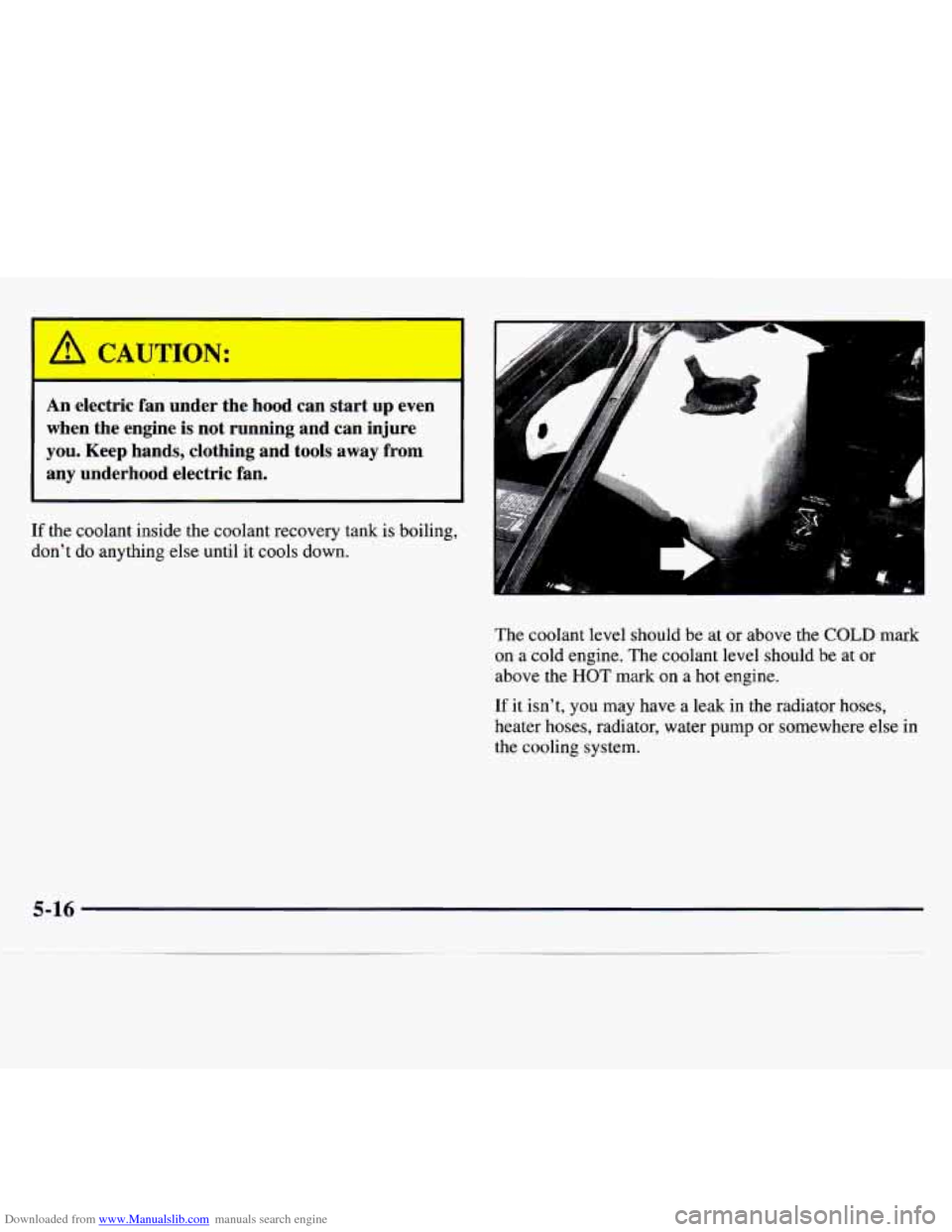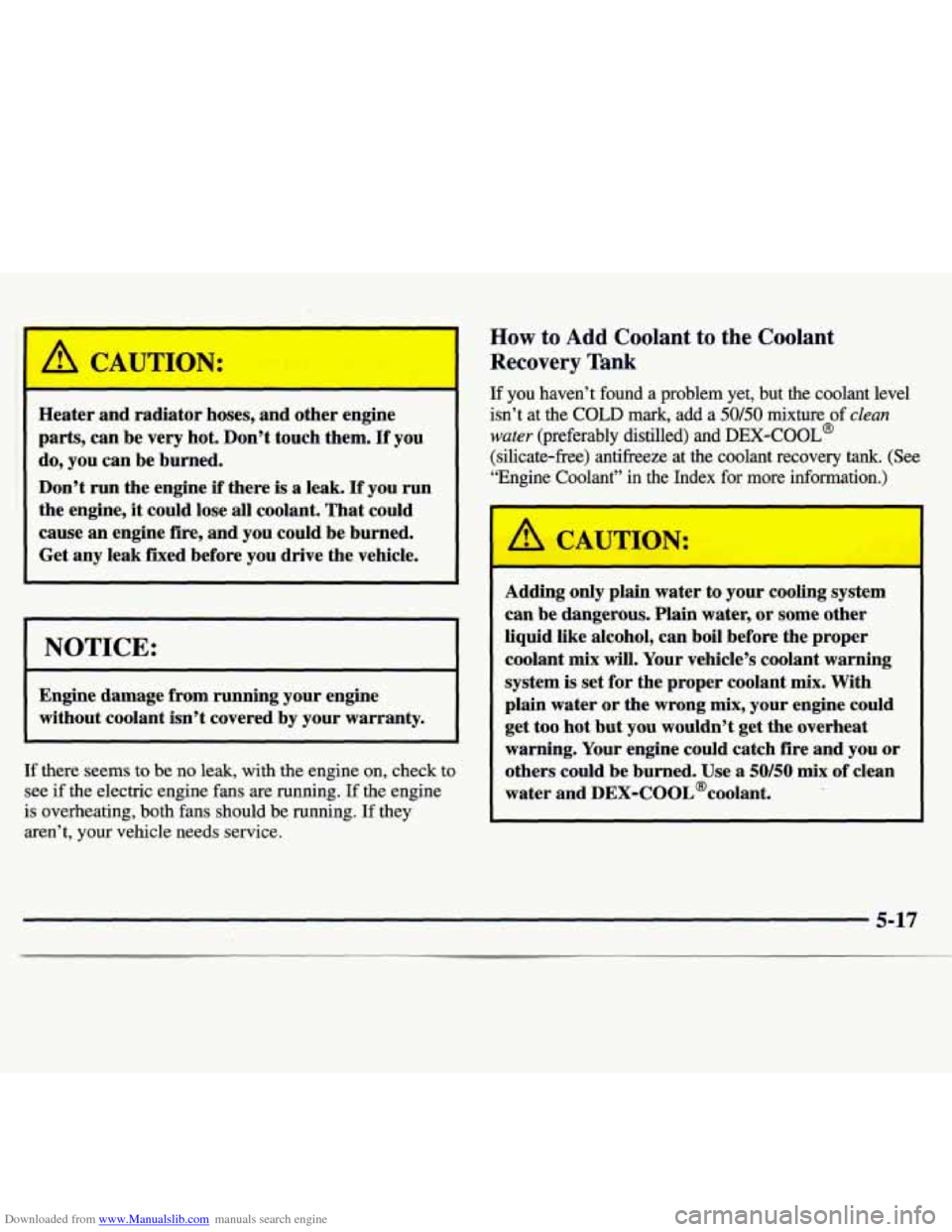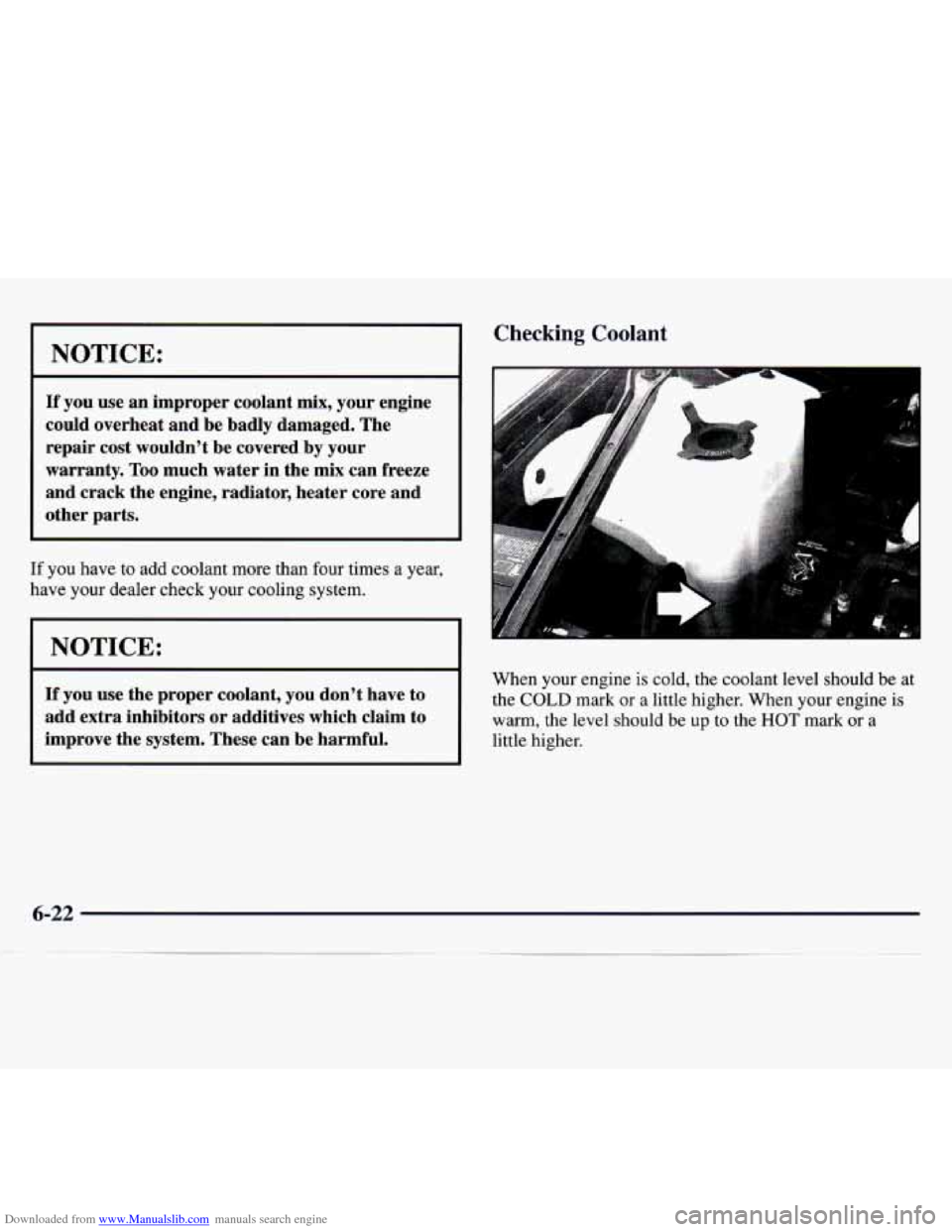1997 CHEVROLET MONTE CARLO coolant level
[x] Cancel search: coolant levelPage 123 of 358

Downloaded from www.Manualslib.com manuals search engine Air Conditioning Heating
On
very hot days, open the windows long enough to let
hot, inside air escape. This reduces the A/C compressor
load, which should help fuel economy.
For quick cool-down on very hot days, use MAX with
the temperature control all the way
in the blue area. If
this setting is used for long periods
of time, the air in
your vehicle may become too dry.
For normal cooling on hot days, use A/C with the
temperature control in the blue area. The system will
bring in outside air and cool it.
On cool but sunny days, the sun may warm your upper
body, but your lower body may not be warm enough.
You can use BI-LEVEL with the temperature control in
the middle. The system will bring in outside air and
direct
it to your upper body, while sending slightly
warmed air to your lower body. You may notice this
temperature difference more at some times than others. On cold days
use FLOOR with
the temperature control
all the way in the red area. The system will bring in
outside air, heat
it and send it to the floor ducts.
If your vehicle has an engine coolant heater, you can use
it to help your system provide warm air faster when it’s
cold outside
(0°F (-18°C) or lower). An engine coolant
heater warms the coolant your engine and heating
system use to provide heat. See “Engine Coolant
Heater”
in the Index.
Page 193 of 358

Downloaded from www.Manualslib.com manuals search engine An electric fan under the hood can start up even
when the engine is not running and can injure
you. Keep hands, clothing and tools away from
any underhood electric fan.
If the coolant inside the coolant recovery tank is boiling,
don't do anything else until it cools down.
The coolant level should be at or above the
COLD mark
on
a cold engine. The coolant level should be at or
above the
HOT mark on a hot engine.
If it isn't, you may have a leak in the radiator hoses,
heater hoses, radiator, water
pump or somewhere else in
the cooling system.
Page 194 of 358

Downloaded from www.Manualslib.com manuals search engine Heater and radiator hoses, and other engine
parts, can be very hot. Don’t touch them.
If you
do, you can be burned.
Don’t run the engine
if there is a leak. If you run
the engine, it could lose all coolant. That could
cause an engine fire, and you could be burned.
Get any leak fixed before you drive the vehicle.
NOTICE:
Engine damage from running your engine
without coolant isn’t covered by your warranty.
If there seems to be no leak, with the engine on, check to
see
if the electric engine fans are running. If the engine
is overheating, both fans should be running.
If they
aren’t, your vehicle needs service.
How to Add Coolant to the Coolant
Recovery Tank
If you haven’t found a problem yet, but the coolant level
isn’t at
the COLD mark, add a 50/50 mixture of clean
water (preferably distilled) and DEX-COOL@
(silicate-fiee) antifreeze at the coolant recovery tank. (See
“Engine Coolant” in the Index for more information.)
’ Adding only plain water to your cooling system
can be dangerous. Plain water,
or some other
liquid like alcohol, can boil before the proper
coolant
mix will. Your vehicle’s coolant warning
system is set for the proper coolant mix. With
plain water or the wrong
mix, your engine could
get too hot but
you wouldn’t get the overheat
warning. Your engine could catch fire and you or
others could be burned. Use a
50/50 mix of clean
water and DEX-COOL%oolant.
5-17
--
Page 200 of 358

Downloaded from www.Manualslib.com manuals search engine 8. Start the engine and let it run until you can feel the
upper radiator hose getting hot. Watch out for the
engine fans.
9. By this time, the coolant level inside the radiator
filler neck may be lower. If the level is lower, add
more
of the proper DEX-COOL@ coolant mixture
through the filler neck until the level reaches the
base of the filler neck.
10. Then replace the
pressure cap. At
any
time during this
procedure if coolant
begins to
flow out of
the filler neck, reinstall
the pressure cap. Be
sure the arrows
on the
pressure cap line up
like this.
1 I. Check the coolant in the recovery tank. The level in
the coolant recovery tank should be at the HOT
mark when the engine
is hot or at the COLD mark
when the engine is cold.
Page 216 of 358

Downloaded from www.Manualslib.com manuals search engine 0 Section 6 Service and Appearance Care
Here you will find information about the care of your Chevrolet. This section begins with service and fuel
information, and then
it shows how to check important fluid and lubricant levels. There is also technical information
about your vehicle, and a part devoted to its appearance care.
6-2
6-3
6-4 6-5
6-7 6- 10
6-16
6- 17
6-20
, 6-24 6-25
6-27
6-30
6-3
1
6-3 1
6-37 6-37 6-45
Service
Fuel
Fuels in Foreign Countries
Filling Your Tank
Checking Things Under the Hood
Engine Oil
Air Cleaner
Automatic Transaxle Fluid
Engine Coolant
Power Steering Fluid
Windshield Washer Fluid
Brakes Battery
Bulb Replacement
Halogen Bulbs
Windshield Wiper Blade Replacement
Tires
Appearance Care 6-46
6-50
6-50
6-50
6-50 6-5 1
6-52 6-52
6-5
2
6-5 3 6-5 3
6-53 6-54
6-55
6-55
6-56
6-65
Cleaning the Inside of Your Chevrolet
Care
of Safety Belts
Cleaning Glass Surfaces
Cleaning the Outside of
the Windshield and
Wiper Blades
Weatherstrips
Cleaning the Outside of Your Chevrolet
Cleaning Aluminum Wheels (If Equipped)
Cleaning Tires Sheet Metal Damage
Finish Damage
Underbody Maintenance
Chemical Paint Spotting
Appearance Care Materials Chart
Vehicle Identification Number (VIN)
Service Parts Identification Label
Electrical System
Air Conditioning Refrigerants
6-1
Page 237 of 358

Downloaded from www.Manualslib.com manuals search engine NOTICE:
If you use an improper coolant mix, your engine
could overheat and be badly damaged. The
repair cost wouldn’t be covered by your
warranty.
Too much water in the mix can freeze
and crack the engine, radiator, heater core and
other parts.
If you have to add coolant more than four times a year,
have your dealer check your cooling system.
I NOTICE: I
If you use the proper coolant, you don’t have to
add extra inhibitors or additives which claim to
improve the system. These can
be harmful.
Checking Coolant
When your engine is cold, the coolant level should be at
the
COLD mark or a little higher. When your engine is
warm, the level should be
up to the HOT mark or a
little higher.
6-22
Page 318 of 358

Downloaded from www.Manualslib.com manuals search engine Part B: Owner Checks and Services
Listed below are owner checks and services which
should be performed at the intervals specified to help
ensure the safety, dependability and emission control
performance of your vehicle.
Be sure any necessary repairs are completed at once.
Whenever any fluids or lubricants are added to your
vehicle, make sure they
are the proper ones, as shown in
Part
D.
At Each Fuel Fill
It is important for you or a service station attendant to
pegorm these underhood checks at each
fuel fill.
Engine Oil Level Check
Check the engine oil level and add the proper oil if
necessary. See “Engine Oil” in the Index for
further details.
Engine Coolant Level Check
Check the engine coolant level and add DEX-COOL@
coolant mix if necessary. See “Engine Coolant” in the
Index for further details.
Windshield Washer Fluid Level Check
Check the windshield washer fluid level in the
windshield washer tank and add the proper fluid
if
necessary. See “Windshield Washer Fluid” in the Index
for further details.
At Least Once a Month
Tire Inflation Check
Make sure tires are inflated to the correct pressures. See
“Tires”
in the Index for further details.
Cassette Deck Service
Clean cassette deck. Cleaning should be done every
50 hours of tape play. See “Audio Systems” in the Index
for further details.
7-37
Page 349 of 358

Downloaded from www.Manualslib.com manuals search engine Electrical Equipment. Adding .......... 2- 14.3.18. 6.56
Electronic Climate Control
........................ 3-2
Engine
.................................... 6.8. 6.9
Coolant
..................................... 6-20
Coolant Heater
............................... 2- 15
Coolant Level Check
.......................... 7-37
Coolant Temperature Gage
..................... 2-53
Coolant Temperature Light
..................... 2-52
Exhaust
..................................... 2-25
Overheating
................................. 5-13
Starting Your
................................ 2-13
Engine Oil
.................................... 6-10
Checking
................................... 6- 11
What Kind to Use ............................. 6-12
When to Change
.............................. 6- 15
Exterior Lamps
................................. 2-33
Identification
................................ 6-55
OilLevelCheck
.............................. 7-37
Runningwhileparked
......................... 2-25
Specifications
................................ 6-64
Adding
..................................... 6-11
Additives .................................... 6-15
Used
....................................... 6-15
Ethanol
........................................ 6-4
Exhaust. Engine
................................ 2-25
Fabric Cleaning
............................... 6-46
FabricProtection
............................... 6-47
Fan Knob, Climate Control System
.................. 3-2
Filling Your
Tank ................................ 6-5
Filter,
Air ..................................... 6-16 Filter. Engine Oil
............................... 6-15
Finishcare
.................................... 6-51
First Gear, Automatic Transaxle
................... 2-19
Flashers, Hazard Warning
......................... 5-2
FinishDamage
................................. 6-53
.............................
FloorMats .................................... 2-41
c
91FZ&
Fluids and Lubricants ............................ 7-42
Foreign Countries, Fuel
........................... 6-4~
Front Parking Bulb Replacement
................... 6-32
Front
Turn Signal Bulb Replacement ................ 6-32
Canadian
.................................... 6-3
Filling Your Tank
.............................. 6-5
In Foreign Countries ........................... 6-4
Fuses and Circuit Breakers
....................... 6-57
Four-Way Manual Front Seat
...................... 1-31
French Language Manual 111
Front Towing .................................. 5-10
Fuel
.......................................... 6-3
.. 1 ...........................
Gage ....................................... 2-59
Gages Engine Coolant Temperature
.................... 2-51
Gear Positions, Automatic Transaxle
................ 2-16
Gross
Axle Weight Rating ........................ 4-29
Gross Vehicle Weight Rating
...................... 4-29
Fuel
....................................... 2-57
GAWR
....................................... 4-29
GloveBox
.................................... 2-38
Guide en Franpis
-11 .. ................................
GVWR ....................................... 4-29
9-4
.